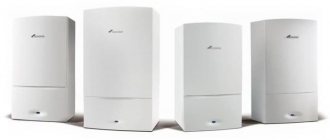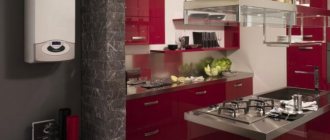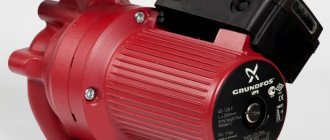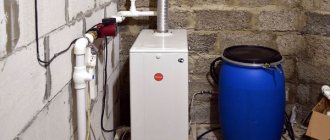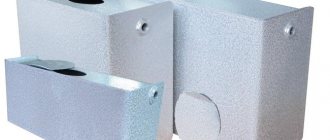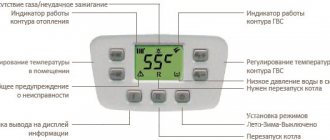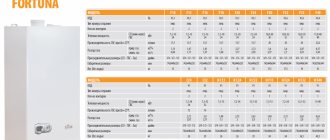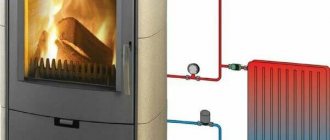When communications are connected to a country house, the problem of heating water and heating can be solved. You will only need to choose a gas boiler, which will occupy one of the main places in the heating system. According to statistics, more than half of the boilers sold today are gas. They come in a wide variety, but you'll need to narrow your search if you're planning on making a similar purchase.
You should take a closer look at several models to evaluate which one is right for you. Consumer opinions are also important. Among others, the market offers gas boilers “Ochag”, which will be discussed below.
Design and main characteristics of a parapet boiler
There are several types of parapet boilers; the following classification will help you choose the right model:
- by installation method: floor and wall, left- and right-handed;
- by number of circuits: single- and double-circuit;
- by the presence of automation: energy-dependent or not.
A few words about the second classification. Single-circuit boilers perform only one function - heating the room; double-circuit ones, in addition, heat the water. The device body has special convection holes that allow you to maintain heat in the room without installing additional radiators.
A parapet boiler can operate either using a portable cylinder or from a conventional gas pipeline. The device body is made of steel; the minimum thickness is 3 mm, and a special powder coating prevents rust, even if the boiler is located in the kitchen, where there is usually high humidity.
The parapet boiler consists of the following parts:
- steel housings;
- closed combustion chamber;
- pilot burner, piezo ignition and thermocouple units;
- exhaust systems in the form of a coaxial chimney facing the street;
- heat exchanger;
- electrical sensors that control the operation of the device.
The chimney allows you to collect combustion air not from the room, but from the street. Combustion products, on the contrary, are released from the apartment. Safety is ensured by the operation of the following components: thermometer, thermocouple and draft sensor.
Types of models
All versions of gas boilers Hearth can be divided into 4 groups:
- AKGV;
- KSGV;
- AOGV;
- KSG.
Devices manufactured under these names can operate in open and closed heating systems. Coolant circulation - forced or natural. Next to the marking there is a number that indicates the power of the device - 7-35 kW. The marking also indicates the type of automation:
- T or AT - SABC AT;
- C — SABC S RD;
- E or EM - Eurosit.
Almost all models are made in accordance with minimalist trends. There is a pressure gauge in front, and other automatic elements are placed in the housing.
A characteristic feature of the products manufactured by ServiceGaz is their white color. The radiator is made of steel, and the burners are made of heat-resistant stainless steel. The device includes condensate collection.
Installation Features
Many owners are trying to find out how to install a gas parapet Thermo boiler? To do this, you should familiarize yourself with the requirements that are specified in government regulations regarding the connection of such equipment. In order not to waste time studying the rules for “Gas distribution systems” and “Gas supply”, it is better to coordinate this with Gorgaz, a service that specializes in connection features and requirements for equipment and premises.
It is important for you to read the technical specifications, which will describe the connection features in your home. To do this, you should write an application to the city gas supply service and indicate the required amount of fuel per hour
After the application is reviewed and satisfied, you can begin to study the technical conditions for installing the boiler and the entire system.
You should not install the boiler yourself, as this is not only unsafe, but also illegal. As a result of your actions, many people may suffer, especially if you live in an apartment.
After all the instructions have been studied, you can begin to design the heating system and the “Gas Supply” project, which indicates the location of the boiler and the layout of the gas pipeline to it. After development, the project is submitted to the service for approval along with the following documents:
- technical passport for the boiler;
- boiler operating instructions;
- certificates certifying compliance with technical requirements and sanitary and hygienic standards;
- expert opinion on the boiler’s compliance with mandatory requirements.
Only after permission from Gorgaz can you proceed to installation.
Installation Requirements
- the boiler must not be installed on combustible materials;
- cannot be placed in corridors, bathrooms, basements, or balconies;
- It is forbidden to install the boiler in a poorly ventilated room or a room without windows;
- You cannot install a boiler in the hostel.
Installation conditions
The first step is to correctly select the parameters of the room for installing the Thermobar gas boiler. The area of the room where the boiler will be located must be at least 4 square meters. The width of the entrance door should not be less than 80 cm. Good lighting and high ceilings are a must. Availability of grounding circuit and cold water pipeline. The chimney must meet requirements that depend on the power of the equipment, so it is important to select a Kolvi parapet gas boiler according to the parameters. The walls of the room should be smooth.
Following these requirements, it is better to place double-circuit models in the kitchen near a gas stove. If the boiler is floor-standing, then it requires a separate room.
Features of installing a wall-mounted boiler
IMPORTANT: It is prohibited to install the boiler and other equipment yourself. First, it is necessary to carry out preparatory work, which includes the presence of specialists with a license to carry out such work and compliance with the temperature regime of 15–25 degrees Celsius
First, it is necessary to carry out preparatory work, which includes the presence of specialists with a license to carry out such work and compliance with the temperature regime of 15–25 degrees Celsius.
We fasten the boiler bracket. Connecting the water
If the model is dual-circuit, it is important not to forget about the need for a mesh filter. We connect the equipment to the gas tap. Using a three-core wire, we connect the electricity. A coaxial pipe should be connected to the boiler, which is led through the wall to the street. Before starting the equipment, fill the system with water
After this, a check is carried out for gas or water leaks.
If the boiler is very powerful, then natural draft may not be enough to remove combustion products. In this case, a forced exhaust is required, which is built in the passage between floors or the roof. To do this, install a pipe with a hatch that can be easily cleaned.
Types and prices
The advantage of such boilers is a large selection of models with different mountings: floor-mounted and wall-mounted. When choosing a boiler, real connection conditions are taken into account.
Boiler equipment from European factories, Russia, CIS countries and China is quite widely represented on the construction market. It is clear that the quality of equipment from the EU is higher than that of boilers from China, but the price is also much higher.
Popular parapet boilers:
- TERMOMAX-C are non-volatile compact boilers for individual heat supply of single-storey and multi-storey buildings, equipped with a flue gas exhaust system through a coaxial channel, horizontally built into the external wall.
Structurally, they are carried out in both single and double-circuit versions with markings E and EB and thermal power from 7 to 16 kW. For heating systems with high hydraulic resistance, a circulation pump is provided. Control, protection and start-up are carried out through the gas valve EuroSit 630. The burner is started using piezo ignition. TermoMax C 16EB has an efficiency of 90% and is capable of heating rooms measuring 120 m2, the cost of the unit is 20,100 rubles. - Another Russian model of a parapet boiler is Lemax Patriot 20 with a closed firebox. The steel heat exchanger is treated with an inhibitory compound and covered with an enamel coating to resist corrosion processes. Mounting type: wall-mounted. The range of thermal loads of Lemax boilers is from 6 to 20 kW. Gas burner equipment from the Italian concern “SIT” with an injection flare burner “POLIDORO”. There are special holes on the front panel to create a convection effect and increase heat transfer in the room. Features include: removable cladding elements, igniter, coaxial smoke removal system, non-volatile installation option. The cost of the unit is 25,820 rubles.
- The double-circuit boiler “Slim 2.300 Fi” is produced by the Baxi brand with a heat load from 14.9 to 29.7 kW, capable of heating objects measuring 140 -160 m2. The boiler is made of high-quality materials, with a price from 120.0 to 140.0 thousand rubles.
- EcoCompact VSC D INT 306/4-5 190L, boiler of the German brand Vaillant - a highly efficient unit, can heat 160-180 m2, price 240.0 thousand rubles.
- The Danko parapet boiler, with a power from 7 to 18 kW, is equipped with a cast iron boiler with a wall thickness of 3 mm and a closed combustion chamber. The universal design allows for two-way connection of utility networks; the control unit is located on the operating panel of the boiler. The units are equipped with Honeywell gas automatics, piezoelectric ignition and a micro-torch burner, heating area up to 160 m2, price – 21 thousand rubles.
- Eurotherm KT TSY (P2) for individual heat supply in systems with natural and forced circulation of the heating circuit, with water heating temperature up to 90 C, thermal power 10 kW, gas consumption 1.13 m3/hour, efficiency 92%, weight 59 kg, warranty period 24 month, heating area 100 m2, price – 24 thousand. rub. Steel boilers are equipped with a copper recovery system with a bypass channel. A specially designed copper coil is placed in a water cavity to produce hot water. Design features: heat recovery system with a receiving tank, housing, control and protection unit, air duct, flue, wind protection cover. The design allows you to install the unit at floor level near the wall. The DHW circuit connecting pipelines are made on one side. The air intake duct passes through the outer wall with a thickness of 200 - 500 mm. Mounting on walls in a wooden house is not allowed without fire protection measures.
Prices: summary table
Rating of the most popular models of parapet gas boilers:
| Model name | DHW, l/min | power, kWt | Efficiency, % | Flow, m3/h | price, rub. |
| LEMAX Patriot-12.5 | —— | 12,5 | 87 | 0,75 | 21 500 |
| ATON Compact-12.5EB | 5–6 | 12,5 | 90 | 1,53 | 25 000 |
| TERMO MAX C-12E | —— | 12,0 | 90 | 1,39 | 18 000 |
| Hephaestus VPR KSG-10S | —— | 10,0 | 92 | 0,60 | 21 500 |
Strengths of parapet heating boilers
Parapet gas boilers have the following advantages:
- Compact sizes. This allows you to easily solve the problem of how to install a parapet gas boiler inside a small apartment, the owners of which have decided to acquire an individual heating system. Equipment of this type can even be installed under the kitchen table or in a niche near the window. The main thing is that the gas pipes reach there.
- High-quality smoke removal. This is ensured by the use of coaxial pipes, which can be laid at any convenient angle.
- Easy to install. This is especially true for wall-mounted parapet boilers. Before installing a floor-standing parapet boiler, you will have to equip a separate room (boiler room) in accordance with the recommendations of the gas service. A prerequisite for using floor-standing gas boilers is a chimney pipe and a wide entrance door (from 80 cm). The boiler room must be equipped with a window for regular ventilation. The chimney must be equipped with a series of small ventilation holes. Parapet boilers do not have similar installation requirements
- Possibility of connection on any part of the heating circuit. Some boilers have only a right- or left-hand installation principle, but this restriction does not apply to parapet devices. Thanks to this, the installation of a parapet gas boiler can be carried out in a convenient place.
- Aesthetics. Parapet models are distinguished by their visual appeal. Most often they are tinted in a light color, which allows them to fit harmoniously into any modern design. Very high-quality material is used to paint the devices, which retains its original decorative qualities over a long period of use. Such a surface is not afraid of sunlight and frequent wet cleaning.
- Ease of management. Gas parapet boilers are equipped with a modern control unit. Thanks to the automatic control system, the condition of the coolant is constantly monitored. If its temperature goes beyond the preset parameters, the sensors immediately send a signal to the main control panel, which turns on the heating or cooling system. The pressure level inside the pipes is controlled in a similar way. Thanks to automation, it is possible to select the most optimal mode of operation of the device, which makes it possible to save energy resources.
- Presence of piezoelectric ignition. This allows a single- or double-circuit parapet gas boiler not to depend on the availability of electrical energy in the room. This is especially convenient outside the city, where power outages often occur.
- Full set. The device is already equipped with all the necessary elements, which are compactly located under a beautiful body. A parapet boiler hung on the wall will not be hung on the sides with additional equipment that spoils the overall interior.
- Possibility of conversion to another fuel. When switching to another type of fuel (electricity, liquefied gas), you do not need to buy new boilers: parapet models can be reconfigured and the nozzles in them can be changed.
In the room where a single-circuit gas parapet boiler is located, heating radiators do not need to be installed. The fact is that the body of the device is equipped with many convection holes through which heat enters the room.
Bottom line
A parapet boiler is an excellent opportunity to solve the issue of organizing heating in any home (private house or apartment). When researching the question of which parapet boiler is better, it is necessary to take into account a number of factors. For example, if in addition to heating it is also necessary to provide heating of water for domestic use, imported double-circuit parapet boilers are available for sale. Some of them do not require connecting a chimney pipe at all. In situations where the home already has a single-circuit heater of low power, the organization of a hot water system can be carried out using a boiler
Flue (atmospheric) boiler
This heating unit operates on natural draft, so the wind can have a significant impact on the combustion process. If there is no draft or the air begins to move in the opposite direction, the automatic system is activated, stopping the gas supply.
If the owners notice that their gas boiler regularly blows out, then they need to determine the cause of this problem. To do this, you need to contact a monitoring organization, whose specialists will check the operation of the chimney.
Depending on what conclusion the experts come to, it will be possible to begin to take measures. Let's look at what needs to be done to stop the boiler from blowing with the wind.
At the first stage, you need to make sure that the chimney is functioning normally and that there are no blockages or ice plugs in it. If this problem does not exist, then other causes of poor traction need to be ruled out.
Installation of the "fungus"
Sometimes, in order to solve the problem, such a simple measure as installing a “fungus” on the end of the pipe is enough. This simple device reduces the likelihood of backdraft. There are several types of fungi:
- cone-shaped;
- in the shape of a ring, larger in diameter than the chimney;
- combined, consisting of a ring and a cone.
Fungus functions:
- dispersion of directed air flow;
- creation of vortices, due to which reverse thrust does not develop.
Another solution to the problem could be to increase the height of the chimney to increase the draft force. Sometimes this has to be done after several years of normal operation of the boiler due to an obstacle that has appeared. For example, if a taller building or other high-rise object is built next to the house.
"Break traction"
If it is impossible to increase the height of the chimney, it is worth trying to organize a so-called “draft break”. To do this, a special device is inserted into the pipe, which prevents the formation of backdraft.
The simplest version of the device has the shape of a truncated cone; it is installed with the wide end towards the boiler. The point of installing such a device is that the air flow entering the pipe loses its strength and forms turbulence, since it cannot freely pass through the narrow part of the cone.
Large chimney diameter
Many people believe that the larger the diameter of the chimney, the better the natural draft. But this is a wrong opinion; moreover, too large a chimney diameter can lead to the burner being blown out by the wind. Why is this happening? The fact is that to create enough thrust, three conditions must be met:
- supply of sufficient air to the firebox to ensure combustion processes;
- achieving a high temperature in the current for the most complete combustion of flue gas;
- heating the inner walls of the chimney pipe.
In order to fulfill the last condition, the inside of the chimney must be assembled from materials with low thermal conductivity. It is clear that the larger the internal diameter of the chimney, the longer it will take to heat them up.
That is, the cause of poor boiler performance can be not only the entry of air flows into the pipe and the creation of reverse draft, but also the insufficient force of forward draft due to the fact that the internal walls of the chimney pipe do not have time to warm up.
To solve this problem, you do not need to disassemble the old chimney; just insert a pipe of a smaller diameter into it. In this case, heating of the inner walls will occur much faster, this will increase the force of direct thrust.
Features of equipment and manufactured models
Vulcan boilers are two lines of modern underfloor heating equipment for heating residential buildings and other buildings. Features and advantages of these units:
- Long service life - the average is at least 14 years.
- High efficiency – it is up to 92%.
- Stable operation in any conditions.
- Durable stainless steel burners.
- Complete energy independence.
- Open combustion chambers.
- Heated area – up to 300 sq. m.
In addition, Vulcan gas boilers are divided into parapet-type models and models with traditional chimneys.
The undoubted advantage of these boilers is the lack of dependence on the electrical network. Thanks to this, they will be able to work in populated areas where there is no gas supply. The presented models are made in a floor-standing form factor, they do not take up much space and have a good, albeit austere, appearance. Let's see what we can find on sale.
Gas boiler Vulcan AOGV 10 E
Before us is a typical model, made according to a single-circuit design using a traditional chimney. It is intended for use in heating systems with forced or natural circulation of water and other types of coolants. There is no second circuit; small-volume, connected “indirect” boilers are used to prepare hot water. In order not to create unnecessary load and not waste heat, you can install an electric storage water heater in your home.
The Vulcan AOGV 10 E boiler is connected to the gas mains, but can also operate on liquefied gas. The control system here is mechanical, with a similar protection system. The heat exchanger is made of steel with additional corrosion protection. The burner manufacturer is the Italian company Polidoro. The thermal power of the unit is 10 kW, gas consumption is up to 1.4 cubic meters. m/hour.
Gas boiler Vulcan AOGV 12 VE
This model is suitable for heating households and other buildings with an area of up to 120 square meters. m. Its power is 12 kW, so taking into account the required reserve, it is better to heat a maximum of 100 square meters. The boiler is built according to a two-circuit scheme, the switching is controlled by Italian automatics, as is customary in similar units from alternative brands. A traditional chimney is used to remove combustion products.
The boiler is connected to the gas main, consuming up to 1.56 cubic meters from it at maximum load. The efficiency is 90%, which is quite a high figure. The operating temperature of the coolant is from +50 to +90 degrees, the volume of boiler water is 19.3 liters.
Gas boiler Vulcan AOGV 9 VPE
Let's move on to parapet models. They differ from traditional Vulcan boilers in that they do not require traditional chimneys to operate. Instead, double pipe-in-pipe (coaxial) chimneys are used, exiting from the rear and extending behind the wall. The presented model is dual-circuit and non-volatile. It is suitable for installation in new households, where conventional chimneys are rarely built. The unit is no different in appearance from its counterparts with open combustion chambers.
The Vulcan AOGV 9 VPE boiler operates from a gas main with a maximum consumption of up to 1.4 cubic meters. m/hour. Its heat exchanger is made of durable steel, protected from corrosion by a special coating. Italian mechanical automation is responsible for controlling the temperature in the pipes and the second circuit. Ignition is carried out from a piezoelectric igniter. The boiler does not require connection to an outlet, and the two-way connection to the heating circuit ensures ease of installation.
Gas boiler Vulcan AOGV 16 VPE
Before us is one of the most powerful parapet-type boilers. It is equipped with a closed combustion chamber; the combustion products released by it are sent outside through a coaxial chimney. Through it, air is taken in for the burner to operate. The power of the device is 16 kW, which is enough to heat rooms up to 160 square meters. As in all other models, the heat exchanger here is made of steel, with additional treatment against corrosion.
The control system is mechanical, made in Italy. It provides switching between circuits and maintaining the set temperature in the heating system. Ignition is carried out by a piezoelectric igniter. Connection to the electrical network is not required, thanks to which the Vulcan AOGV 16 VPE boiler can be operated in buildings not connected to gas mains.
How to light a boiler?
In order to ignite the Hearth boiler, you need to turn the control knob clockwise until the point is opposite the pointer. Then press and hold the start button. Press the piezo ignition button until you hear a characteristic click. At this time, the igniter lights. We continue to hold the start button pressed while the thermocouple heats up. The gas block operates automatically on the igniter. Next, turn the knob counterclockwise to the required temperature.
The Hearth boiler achieves high efficiency due to efficient combustion of fuel and high heat transfer from flue gases through “flame” pipes to the coolant and a developed firebox. The manufacturer guarantees a service life of at least 15 years. Factory warranty for the product is 24 months.
Watch a video on how to light a gas boiler with Eurosit630 automation
Installation features
Correct installation of the boiler is the key to a productive heating system and fire safety. The requirements for the installation site of a floor-standing boiler are:
- installation is carried out on a flat surface protected from freezing;
- there should be a power outlet with grounding nearby;
- safe distance from furniture and other interior elements;
- equipped boiler room.
As a rule, a medium-sized apartment requires a boiler with a capacity of 6-20 kW. If you choose a model with automatic transmission, this will save up to 12% on fuel consumption, which is an undeniable advantage.
If any difficulties arise, our manager will advise you over the phone on the characteristics of the equipment and help you make the right choice.
How to calculate the minimum required power
In most cases, to determine power (Q), a simplified formula is used, where 1 * kW of thermal energy is taken per 10 m2 of heated area.
- *approximate heat loss of a brick building with ceilings of 2.7 m from the central climatic zone of Russia.
For example, for a residential building of 120 m2 located in the Moscow region, the minimum required power of a parapet gas boiler will be Q=120÷10×1=12 kW.
We also recommend making a reserve of 15–20% of the power so as not to operate the heat generator at its limit for a long time, i.e. for the same object Q≈14–15 kW. Also, if we are talking about a double-circuit model, then you will have to add about 15–20% more to provide hot water supply, the total result will be Q≈16–17 kW.
In an apartment of 120 m2 (not corner), heat loss is a priori 10–15% less, so for a unit with one circuit Q≈12.5–13 kW, with two circuits Q≈14.5–15 kW.
How to accurately calculate the required boiler power Individual calculation, formula and correction factors
Service
Some malfunctions identified during operation can be eliminated yourself:
- Problems with the traction sensor. It can cause an emergency shutdown when there is excellent traction. False alarms occur due to oxidation of the contacts - they need to be cleaned. If the sensor is completely broken, it is easy to replace it with a new one.
- Problems with the igniter. Ignition does not occur due to weak combustion of the wick. How to fix the situation? Set the desired flame power. You can read about this in detail in the instructions. The equipment is also supplied with a connection diagram and data sheet.
In almost any specialized store you can buy components and parts that need to be replaced. Repairs may only be carried out by authorized personnel.
Possible faults
The chimney must be cleaned annually so that no problems arise during the heating season.
The main problems when operating the boiler are related to the operation of the burner: the flame goes out or burns poorly. The reason may be the following:
- reverse thrust;
- draft;
- strong wind outside;
- lack of gas in the main;
- gas valve malfunction;
- nozzle clogging;
- problems with gas equipment.
If any gas heating malfunction occurs, you cannot independently find out the cause or carry out repairs. The first step is to turn off the gas supply from the main and call the gas service. Repairs to gas equipment must be carried out by a specialist.
Do-it-yourself installation of a parapet gas boiler
It is necessary to begin the installation of heating equipment by carefully studying the instructions and safety rules described in it. It must also be remembered that the commissioning of the boiler is approved by gas services. If you installed the boiler yourself, then involve specialists in consultation to complete the correct installation.
The process takes place in several stages.
Installation conditions
First, choose the optimal location for installing the boiler, in accordance with existing standards.
The equipment is installed only in premises that are classified as non-residential (kitchen, hall, utility rooms).
The outlet for the chimney pipe must be located on an external surface that is resistant to fire. In most models, it comes with a metal casing. It is attached directly around the diameter of the pipe outlet on the outer wall. If there are elements on the chimney outlet wall that can ignite when heated, then the distance to them should be at least 20-35 cm.
It is strictly forbidden to lead the chimney onto balconies and loggias, into passage arches, especially into the entrance. It must be remembered that toxic combustion products are removed.
It is prohibited to install the exhaust chimney near the supply ventilation intakes (distance from 60 cm - for low-power boilers; up to 1.5 meters - for equipment with a power of over 7 W). If the inlet ventilation and chimney are located close together, exhaust gases may enter the supply ventilation ducts.
Periodically, the chimney will need to be cleaned, so it would be more correct to place it in a place where it can be accessed, for example, under a window.
For the first floors, it is preferable to install a mounted boiler, approximately at a height of 2-2.2 meters.
Indoors, flammable surfaces must not be placed closer than 30 cm around the boiler (upholstered furniture, curtains, tulle).
There must be access to the system from all sides, at least one meter.
Boiler installation
You will need the following tools: a diamond drill for making a hole in the wall, boiler fasteners, a level, caps (shut-off valve), an adjustable wrench.
Installing a parapet boiler with your own hands requires certain practical skills.
Sequencing:
- First, a hole is punched in the wall, the size of the outer diameter of the chimney. For this purpose, special diamond drills with a diameter of 240-270 mm are used.
- Then the outer contour of the coaxial pipe is installed. The chimney is installed at an angle of 4-5 mm to allow condensation to drain.
- Next, fasteners for the mounted boiler are screwed in and markings are made for the floor section.
- Install a water supply system and gas outlet.
- The internal chimney pipe is fixed.
- Install the boiler, connect the water and gas connections to it, and the heating system pipes.
The last stage will be the control launch of the boiler. It is more correct to carry it out in the presence of a specialist. Make sure that the flame is even, there is a special viewing window for this. Check to see if the gas has leaked or water has leaked at the joints.
Models and their characteristics
Let us note the technical characteristics of the most popular models of Ochag gas boilers.
KSG-7AT
This energy-dependent single-circuit unit has an affordable price. The approximate cost is 10,000 rubles. The material used for manufacturing is steel. Available in a floor-standing version, the device is very simple and convenient to use.
Gas boiler Ochag KSG-7 AT
This gas boiler Ochag consumes fuel economically, the device is able to effectively heat a room of 80 m². Specifications:
- power is 7 kW;
- high efficiency - 85%;
- water pressure - 0.1 MPa.
The unit operates without failures or malfunctions even with minimal pressure in the pipeline. The package includes a gas block, a built-in pressure and draft stabilizer, and a compact steel heat exchanger. The burner is made of heat-resistant stainless steel. It is simple and convenient to maintain - you can easily remove the lining, gas is connected on both sides. There is a device that collects condensate.
Users note that this model has good characteristics. If you replace the burner nozzles, you can use liquefied gas as fuel.
KNG 24
Hearth KNG-24
The approximate price for such equipment is 25,000 rubles. It is double-circuit, wall-mounted, and small in size. Features a stylish design.
The device is absolutely silent in operation - you can install it directly in the room, it will not create discomfort.
There is a liquid crystal screen on the front panel that displays the current parameters. The boiler can be used for heating rooms that are equipped with a water heating system, as well as for heating water.
Technical indicators:
- high productivity, efficiency reaches 90%;
- efficiently heats rooms up to 220 m²;
- maximum heating power is 24 kW;
- there is auto-ignition;
- gas consumption is 2.6 m³/hour.
A heated floor system can be connected to such units. The combustion chamber is closed and can run on natural or liquefied gas. There are several stages of automatic protection. The mass of the boiler Ochag KNG 24 is 36 kg.
KSG-11
KSG-11 is a floor-standing gas boiler Ochag, designed for heating premises for various purposes.
Installation is simple and convenient, because gas can be connected from any side. The door can be mounted on any side convenient for the user.
There is a device for collecting condensate, the heat exchanger is made of steel, the thermal insulation is 30 mm. The combustion type is low-flame; the device does not make any noise during operation.
Technical specifications:
- heating capacity is 11 kW;
- the maximum area that the unit can heat is 125 m²;
- Efficiency - 85-90%;
- gas consumption is 1.34 m³/hour;
- weight - 48 kg.
KSTG-16
Combined single-circuit boiler, maximum power is 16 kW. The device operates on gas and coal. Designed to supply heat to rooms up to 160 m². Floor-standing installation, without automatic ignition and flame modulation. Efficiency - 75%.
KSG 10-AT
The unit is floor-standing, the heating capacity is 10 kW, it heats a room up to 100 m².
Gas boiler Ochag KSG-7 AT
Fuel consumption is 1.11 m³/hour. The cost of the device is 11,000 rubles.
If you replace the burner nozzles, you can use liquefied gas as fuel. The unit has a compact size, dimensions - 25x47x75 cm. Weight - 48 kg. Tank capacity is 18 liters.
KSG-7 E
Floor-standing single-circuit gas boiler Ochag KSG-7 E, which is characterized by stable operation at low pressure in gas supply pipes. It is small in size, has an attractive design, is fuel efficient, and effectively heats houses up to 80 m² in size. The weight of the device is 37 kg.
The combustion chamber is open, there is no automatic ignition, and there is also no flame modulation. This model is inexpensive, but its functionality is very narrow.
Summarizing all of the above, it is worth noting that Ochag gas boilers occupy a worthy place in the domestic market among the variety of heating appliances. A wide selection of models according to technical characteristics, appearance and price allows each user to choose the most optimal option. Owner reviews of Ochag boilers are mostly positive. Their effectiveness and ease of use are noted.
You can also pay attention to German, Japanese, Korean, Czech and Ukrainian gas boilers
About the manufacturer
The ServiceGaz company began its activities in 1993 in the city of Ulyanovsk. Today, this manufacturer supplies the domestic market with more than 60 modifications of gas boilers.
Domestic gas boilers and their manufacturers are presented here
The products are in wide demand among users due to their good technical characteristics and reasonable price. Currently, the average cost of units operating on gas is 14,000-17,000 rubles. Boilers are capable of heating rooms from 70 to 1000 m², it all depends on the specific model.
What are parapet gas boilers?
A parapet gas boiler is a compact boiler unit used for heating (single-circuit) and supplying objects with hot water (double-circuit).
In general, such models were initially developed as a non-volatile alternative to wall-mounted devices, but unlike the latter, they are universal when choosing a place for installation, i.e. they can be placed either wall-mounted or floor-mounted. The only condition is that it must be secured to the outer wall of the room, preferably below the line of the window sills.
Design and principle of operation of the equipment
In terms of functionality, parapet gas boilers are something between a classic atmospheric heat generator and an air convector.
This combination is achieved by modifying standard components:
- closed combustion chamber - completely isolated from the living space, which eliminates any influence of smoke products on the internal microclimate;
- primary heat exchanger - has dissipative turbulators that increase the passage time of air flows and prevent heat from evaporating;
- air intake and smoke removal system - implemented through a short (from 25 cm to 53 cm) coaxial pipe, without complex elbows, wiring and insulation;
- sealed steel housing - equipped with a viewing window for direct visibility of the burner flame, as well as convection holes, the so-called. ribs.
Schematic representation of the design and operating principle of parapet models.
The operating principle of parapet boilers is not entirely typical: despite the closed combustion chamber, they operate according to a natural air exchange (draft) scheme - street oxygen is supplied through the outer part of the pipe from below to the burner that heats the heat exchanger, after which the smoke is removed through the core of the pipe.
Under what conditions is it most advisable to use such boilers?
Parapet models are used to organize heating and hot water supply (DHW) systems in buildings whose design does not involve the construction of a full-fledged chimney, as well as with problems in power supply and other aspects: stable pressure, soft water and high-quality fuel.
However, it is necessary to take into account the power limitation in the range from 4 to 46 kW, i.e., in terms of similar indicators, “parapets” are seriously inferior to both wall-mounted and, even more so, floor-standing units. This means that it is reasonable to install them only in relatively small rooms (from 30 to 250 m2), such as private and country houses, retail sites, offices in shopping centers and, of course, high-rise apartments, in which they fit perfectly into the niche under the windowsill in the kitchen.
Possibility of installing a parapet boiler in a wooden house
Almost any wooden house can be equipped with a parapet boiler: the exception is barracks and other old-style apartment buildings.
Installation is carried out according to the current rules of SNiP 42-101-2003:
- the unit is placed on an external wall, while an empty gap should remain outside - from 0.3 to 3.1 m (depending on the power), without facade elements;
- The chimney outlet must not be installed near or directly in enclosed spaces (entry, attics, entrances, balconies, loggias, etc.);
- the mounting wall is sheathed with fire-resistant material and covered with a sheet of steel so that there is a distance of 10–25 cm to difficult and easily flammable areas;
- porous wood, in order to increase fire safety, is prepared in advance for overlapping, treated with special mastics and impregnations in 2-3 layers.
Many companies still use asbestos to protect walls from fire, although today it is officially recognized as a material hazardous to health. Ceramic or silicate bricks, GVP-slabs, mineral wool, basalt insulation, foam and aerated concrete panels, and even gypsum plaster can help replace it.
Designations
Heating devices are designated by a letter abbreviation. Each letter contains certain information:
- K - boiler;
- G — the package includes gas burner equipment;
- T - can be used as solid fuel;
- C - steel;
- M - you can install heating elements and an expanded combustion chamber;
- B - there is a water heater.
By understanding what the letters mean, users will be able to decipher basic information about the product.
Other tips
The living room with the kitchen can be combined and decorated with various shortcomings
It is important to calculate and anticipate everything in advance. Decorators and craftsmen share tips that will help avoid problems during repairs and furnishings:
The result depends on how detailed the project is drawn up. Oddly enough, it is worth taking into account the growth of loved ones and relatives. It is also recommended to calculate the approximate number of possible guests. You can get rid of food smells by installing a strong hood or ventilation system.
Small models are more suitable for housewives who do little cooking. If you plan to have a sleeping place in the living room, then it is important that the ringing of appliances and other kitchen utensils is not heard. Silent dishwashers and other appliances will come in handy.
In addition, you can install a sliding door and install a soundproof partition. If there is sensitivity to ultraviolet radiation, the owners hang thick curtains made of light-proof fabric. If household appliances do not match the direction of the interior, they are hidden behind furniture or put away in kitchen cabinets. When installing luminaires and lamps, they are guided by several criteria
It is important that the light falls evenly throughout the entire space. Especially bright lighting is preferable in the kitchen area and where the dining table is installed
In the living room, designers create a subdued atmosphere using wall sconces and table lamps. Multi-level stretch ceilings with LED strip also look good in this room. Moisture-resistant finishing materials are more durable and easy to clean. Thus, they retain their appearance for a long time. The kitchen combined with the living room combines:
- personal tastes of the owners;
- reliable finishing materials;
- current design ideas;
- convenience;
- trends. The best photos of kitchen living room design
